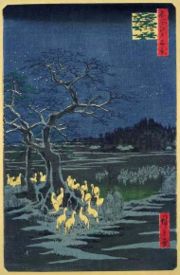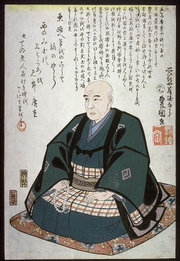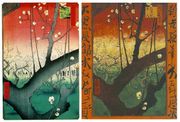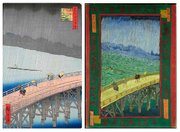Hiroshige
2008/9 Schools Wikipedia Selection. Related subjects: Artists
Utagawa Hiroshige, (pronounced [utagaɰa çiɺ̠oɕige], Japanese: 歌川広重; 1797 in Edo – October 12, 1858) was a Japanese ukiyo-e artist, and one of the last great artists in that tradition. He was also referred to as Andō Hiroshige (安藤広重) (although this combination of a family name with an art name is irregular) and by the art name of Ichiyūsai Hiroshige (一幽斎廣重).
Early life
Hiroshige was born in 1797 and named "Andō Tokutarō" in the Yayosu barracks, just east of Edo Castle in the Yaesu area of Edo (present-day Tokyo). His father was Andō Gen'emon, a hereditary retainer (of the dōshin rank) of the shōgun. An official within the fire-fighting organization whose duty was to protect Edo Castle from fire, Gen'emon and his family, along with 30 other samurai, lived in one of the 10 barracks; although their salary of 60 koku marked them as a minor family, it was a stable position, and a very easy one — Professor Seiichiro Takahashi characterizes a fireman's duties as largely consisting of revelry. The 30 samurai officials of a barracks, including Gen'emon, oversaw the efforts of the 300 lower-class workers who also lived within the barracks. A few scraps of evidence indicate he was tutored by another fireman who taught him in the Chinese-influenced Kanō school of painting.

Legend has it that Hiroshige determined to become a ukiyo-e artist when he saw the prints of his near-contemporary, Hokusai. (Hokusai published some of his greatest prints, such as Thirty-six views of Mount Fuji, in 1832 — the year Hiroshige devoted himself full-time to his art.) From then to Hokusai's death in 1849, their landscape works competed for the same customers. More likely though, like many other low-ranked samurai, Hiroshige's salary was insufficient for his needs, and this motivated him to look into artisanal crafts to supplement his income. It was easy to balance his job and his artistic pursuits, as a fireman was only intermittently busy.
His natural inclination toward drawing marked him for an artistic life: as a child, he had played with miniature landscapes, and he was already moderately well-known for a remarkably accomplished (for his age) painting in 1806 of a procession of delegates to the Shogun from the Ryukyu Islands. He began by being taught the Kano school's style by his friend, Okajima Rinsai. These studies (such as a study of perspective in the Dutch images imported) prepared him for an apprenticeship. He first attempted to enter the studio of the extremely successful Utagawa Toyokuni but was rejected. Thus, he eventually embarked (he was rejected again on his first attempt to enter Toyohiro's studio) on an apprenticeship at the age of 15 in 1811 with the noted Utagawa Toyohiro instead of with Toyokuni; Toyohiro bestowed upon him the name "Utagawa" after only a year (instead of the normal two or three years). Hiroshige later took his master's name, becoming "Ichiyūsai Hiroshige."
In his early apprenticeship to Toyohiro, he showed little sign of artistic genius and did not publish much. Despite earning an artistic name ("Ichiyūsai Hiroshige") and school license at the young age of 15, Hiroshige's first genuinely original publications came only in 1818 (six years later; this was also the year he was commended for his heroism in fighting a fire at Ogawa-nichi) with his Eight Views of Lake Biwa and Ten Famous Places in the Eastern Capital. These were moderately successful, but his Famous Places in the Eastern Capital (1831) attracted his first real notice. It is speculated he wiled away the interim between his initial apprenticeship and 1818 engaging in work for Toyohiro's school, like painting fans and other small items. This sort of work supported him as he continued to study the Kanō and Shijō painting styles. But all these were but precursors to the series of prints that made him famous. In 1832, Hiroshige was invited to join an embassy of Shogunal officials to the Imperial court. As his son, Nakajiro, could handle his fireman duties, Hiroshige joined it and carefully observed the Tōkaidō Road (or "Eastern Sea Route"), which wended its way along the shoreline, through a snowy mountain range, past Lake Biwa, and finally to Kyōto. His series of prints, The Fifty-Three Stations of the Tokaido, was extremely successful, and Hiroshige's career was assured, though he never lived in financial comfort even in old age.
In 1839, Hiroshige's first wife, a woman from the Okabe family, died. Hiroshige re-married O-yasu, daughter of a farmer named Kaemon.

Hiroshige lived in the barracks until he turned 43. Gen'emon and his wife died in 1809, when Hiroshige was 12 years old, just a few months after his father passed the position to him. He did not shirk his (admittedly light) duties as a fire-fighter, fulfilling them even after he had entered training in Utagawa Toyohiro's ukiyo-e school in 1811, and even when he had become an acclaimed wood-block print artist. He eventually turned his position over to Hiroshige III in 1832.
Hiroshige II and Hiroshige III
Hiroshige II was a young print artist named Shigenobu, who married Hiroshige's daughter (either adopted or from his second marriage), Tatsu. Hiroshige intended to make Shigenobu his heir in all matters, but Tatsu and Shigenobu separated. Shigenobu nevertheless began using the name Hiroshige and so is known as Hiroshige II. Tatsu remarried another artist, named Shigemasa, who became Hiroshige's heir, as a fireman and in using his name; he is known as Hiroshige III. Neither Hiroshige II nor Hiroshige III achieved the level of success and recognition achieved by, and accorded Hiroshige.
Late life
In his declining years, Hiroshige still produced thousands of prints to meet the demand for his works, but few were as good as those of his early and middle periods. In no small part, his prolificacy stemmed from the fact that he was poorly paid per series, although he was still capable of remarkable art when the conditions were right — his great One Hundred Famous Views of Edo was paid for up-front by a wealthy Buddhist priest in love with the daughter of the publisher, Uoya Eikichi (a former fishmonger).
In 1856, Hiroshige "retired from the world," becoming a Buddhist monk; this was the year he began his One Hundred Famous Views of Edo. He died aged 62 during the great Edo cholera epidemic of 1858 (whether the epidemic killed him is unknown) and was buried in a Zen Buddhist temple in Asakusa. Just before his death, he left a poem:
- "I leave my brush in the East
- And set forth on my journey.
- I shall see the famous places in the Western Land."
- And set forth on my journey.
(The Western Land in this context refers to the strip of land by the Tōkaidō between Kyoto and Edo, but it does double duty as a reference to the Paradise of the Amida Buddha).
Works
Hiroshige largely confined himself to common ukiyo-e themes such as women (bijin-ga) and actors (yakushae). Only when he was 27 did he transfer the headship of his clan to his uncle. But Hiroshige made a dramatic turnabout, when after 17 years, Toyohiro died, and Hiroshige came out with the landscape series Famous Views of the Eastern Capital (東都名所 Tōto Meisho) in 1831, which was critically acclaimed for its composition and colors. This set is generally distinguished from Hiroshige's many print sets depicting Edo by referring to it as Ichiyūsai Gakki, a title derived from the fact that he signed it as Ichiyūsai Hiroshige. With Fifty-three Stations of the Tōkaidō (1833 – 1834), his success was assured; the prints, drawn from Hiroshige's actual travels of the full 490 kilometers, along with details of day, location, and anecdotes of his fellow travelers, were immensely popular. In fact, this series was so popular that he reissued it in three versions, one made jointly with Kunisada. Hiroshige went on to produce more than 2000 (of his estimated total 5000) different prints of stops along the Edo and Tōkaidō Road, as well as series such as Sixty-nine Stations of the Kisokaidō (1834-1842).
He dominated landscape printmaking with his unique brand of intimate, almost small-scale works (at least when compared against the older traditions of landscape painting descended from Chinese landscape painters through Sesshu). The travel prints generally depict travelers along the famous routes traveling and experiencing the special attractions of various stops along the way. They travel in the rain, the snow, and during all of the seasons. In 1856, working with the publisher Uoya Eikichi, he created a series of high quality prints, made with the finest printing techniques including true gradation of colour, the addition of mica to lend a unique iridescent effect, embossing, fabric printing, blind printing, and the use of glue printing (wherein ink is mixed with glue for a glittery effect). One Hundred Famous Views of Edo (issued serially between 1856 and 1859) was immensely popular. The set was not published until after his death, so not all of the prints were completed by him--he created over 100 on his own, but two were added by Hiroshige II after his death.
Influence
The younger rival of Katsushika Hokusai, Hiroshige was a member of the Utagawa school, along with Kunisada (1786-1865) and Kuniyoshi (1797-1861). The Utagawa school, containing hundreds of artists, stood at the forefront of nineteenth century woodblock prints. Particularly noteworthy for their actor and historical prints, members of the Utagawa school were nonetheless well-versed in all of the popular genres.
During Hiroshige’s time, the print industry was booming and the consumer audience of prints was growing rapidly. Previously, prints had been issued in sets of ten or twelve, but the number of prints within a set was increasing at this time. This trend can be seen in Hiroshige’s own work, from Sixty-nine Stations of the Kisokaidō to One Hundred Famous Views of Edo.
In terms of his style, Hiroshige is especially noted for using unusual vantage points, seasonal allusions, and striking colors. He adapted Western principles of perspective and receding space to his own works in order to achieve a sense of realistic depth. Even more, he worked extensively within the realm of meishoe, pictures of famous places. During the Edo Period, tourism was also booming, leading to increased popular interest in travel. Travel guides abounded and towns appeared along routes such as the Tōkaidō, the road that connected Edo with Kyoto. In the midst of this burgeoning travel culture, Hiroshige drew upon his own travels and tales of others’ adventures for inspiration in creating his landscapes. For example, in Fifty-three Stages on the Tōkaidō (1833) he illustrates anecdotes from Travels on the Eastern Seaboard (Tōkaidōchū Hizakurige, 1802-1809) by Jippensha Ikku, a comedy describing the adventures of two bumbling travelers as they make their way along the same road.
Hiroshige’s Fifty-three Stations of the Tōkaidō (1833 – 1834) and One Hundred Famous Views of Edo (1856 – 1858) greatly influenced French Impressionists like Monet. Vincent Van Gogh also copied two of the One Hundred Famous Views of Edo. Hiroshige also influenced the Mir iskusstva, a 20th century Russian art movement of which Ivan Bilibin was a major artist.

![A rather dark printing of the view sometimes dubbed "Man on Horseback Crossing a Bridge". From the series Sixty-nine Stations of the Kisokaidō, this is View 28 and Station 27 at Nagakubo-shuku, depicting the Wada Bridge across the Yoda River[1].](../../images/108/10847.jpg)

